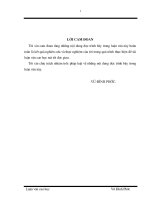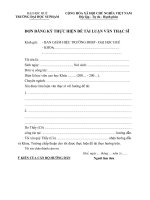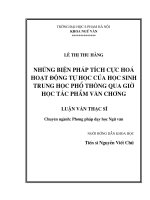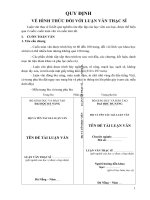(Luận văn thạc sĩ) study on mobile payment adoption in vietnam
Bạn đang xem bản rút gọn của tài liệu. Xem và tải ngay bản đầy đủ của tài liệu tại đây (840.78 KB, 63 trang )
VIETNAM NATIONAL UNIVERSITY, HANOI
VIETNAM JAPAN UNIVERSITY
------------------
DAO MANH TAN
STUDY ON
MOBILE PAYMENT ADOPTION
IN VIETNAM
MASTER’S THESIS
BUSINESS ADMINISTRATION
Hanoi, 2019
VIETNAM NATIONAL UNIVERSITY, HANOI
VIETNAM JAPAN UNIVERSITY
DAO MANH TAN
STUDY ON
MOBILE PAYMENT ADOPTION
IN VIETNAM
MAJOR: BUSINESS ADMINISTRATION
CODE: 60340102
RESEARCH SUPERVISORS:
ASSOC PROF. NGUYEN VAN DINH
PROF. MOTONARI TANABU
Hanoi, 2019
DECLARATION OF ACCEPTANCE
I declare that this master thesis has been conducted solely by myself. This
master thesis has not been submitted in any previous articles or application for a degree,
in whole or in apart. The work contained herein is my own except where stated
otherwise by reference or acknowledgment.
ACKNOWLEDGMENTS
I would first thank both advisors Prof. Tanabu of Graduate School of
International Social Science – Yokohama National University. I would like to express
my gratitude to professor Tanabu for all the useful comments and engagement through
the chain of seminars in YNU. Furthermore, I would like to thank Assoc Prof. Nguyen
Van Dinh of Vietnam National University for wise advised and steered me in the right
direction whenever I need in conducting this research.
I would like to express my sincere thanks for all of the VJU –MBA02 class for
their kind support and advised. Next, I would like to thank my survey’s participant who
shared their time and precious idea.
Finally, I would like to express my gratitude to my parents to support me
unfailing and continuous encouragement throughout my study and writing this thesis.
This accomplishment would not have been possible without them.
ABSTRACT
In Vietnam “The number of e-payments grew 22% in 2017 from the previous year
to $6.14 billion, according to Statista, a local market research firm. The figure is
projected to double to $12.33 billion in 2022” (TOMIYAMA, 2018) State-owned gas
station operator Petro Vietnam Oil introduced a mobile payment system in February,
while M-Service, a major fin-tech company, plans to increase the number of
subscribers to its MoMo online payment service to 50 million by 2020 from about five
million today. The research focuses on 3 objectives: To find the factors that affect the
customer in selecting the mobile-payment application in Vietnam, the relationship
between those factors and propose suggestions and solutions for mobile-payment
application providers to attract more customers as well as improve business
efficiencies. The research constructs and develop on the ground of UTAUT theory with
revised of Facilitating Factor, Trust factor and changes an independent variable. The
research using Likert –scales 5 levels for 4 observation variables: Performance
expectancy, social influence, effort expectancy Trust and one dependent variable
Behavior Intention. The research using a frequency- scale 4 levels for one independent
variable: E-commerce Use Behavior and one dependent variable: Use behavior.
Among 6 hypotheses, 5 were not rejected and 1 was rejected. The research also
provided the multiple linear regression equation and binomial logistic regression
equation of computing variable value. Therefore, predicting the mobile payment usage
behavior of frequency at 75.85% accuracies.
TABLE OF CONTENTS
CHAPTER 1: INTRODUCTION .................................................................................... 1
1.1.1 Practical Motivation.................................................................................... 1
1.1.2 Theoretical Motivation ............................................................................... 3
CHAPTER 2: LITERATURE REVIEW ..................................................................... 6
2.1.1 Theory of Reasoned Action (TRA) ............................................................ 6
2.1.2 Theory of Planned Behavior (TPB) ............................................................ 6
2.1.3 Theory of Technology Acceptance Model (TAM) ..................................... 8
2.1.4 The Unified Theory Of Acceptance And Use Of Technology (UTAUT) .. 8
2.3.1 Performance Expectancy .......................................................................... 14
2.3.2 Effort Expectancy ..................................................................................... 15
2.3.3 Social Influence ........................................................................................ 16
2.3.4 Trust .......................................................................................................... 17
2.3.5 Behavioral Intention ................................................................................. 18
2.3.6 E-Commerce Behavior Intensive .............................................................. 19
2.3.7 Use Behavior............................................................................................. 20
CHAPTER 3: RESEARCH METHODOLOGY ....................................................... 22
3.2.1 Research Scale .......................................................................................... 23
3.2.2 Example method and data collection ........................................................ 23
3.2.3 Data Analysis Method .............................................................................. 24
CHAPTER 4: RESEARCH FINDINGS ................................................................... 26
4.4.1 Exploratory Factor Analysis (EFA) .......................................................... 30
4.6.1 Block 0: Beginning Block ........................................................................ 35
4.6.2 Block 1: Method = Enter .......................................................................... 35
CHAPTER 5: CONCLUSIONS AND RECOMMENDATIONS............................. 39
REFERENCES .......................................................................................................... 42
APPENDIX ................................................................................................................ 45
QUESTIONAIRES ................................................................................................ 53
LIST OF TABLE
Table 2.1 Performance expectancy scale ................................................................... 15
Table 2.2 Effort expectancy scale .............................................................................. 16
Table 2.3 Social influence scale ................................................................................ 17
Table 2.4 trust scale ................................................................................................... 18
Table 2.5 behavioral intention scale .......................................................................... 19
Table 2.6 ecommerce behavior scale ......................................................................... 20
Table 3.1 Research process ........................................................................................ 22
Table 4.1 item total statistics of trust variable - original ........................................... 28
Table 4.2 item total statistics of trust variable after deleted tr6 ................................ 29
Table 4.3 cronbach's alpha ......................................................................................... 29
Table 4.4 Component analysis ................................................................................... 30
Table 5.1 item total statistics of effort expectancy variable ...................................... 45
Table 5.2 item total statistics of social influence variable ......................................... 45
Table 5.3 item total statistics of behavioral variable ................................................. 46
Table 5.4 item statistic of use behavior variable ....................................................... 46
LIST OF FIGURE
Figure 2-1 Theory of reasoned action .......................................................................... 6
Figure 2-2 Theory Of Planned Behavior ..................................................................... 8
Figure 2-3 UTAUT model ......................................................................................... 10
Figure 2-4 Revised UTAUT model with trust and E-commerce Behavior Intensive
........................................................................................................................................ 12
Figure 4-1 Revised Research Model .......................................................................... 37
CHAPTER 1: INTRODUCTION
1.1. Research motivation
1.1.1 Practical Motivation
In the Asia region and ASEAN region: The movement of banking system along with
a big leap of personal smartphone devices rate in ASEAN. According to Nikkei Asian
Review " In Indonesia, Digi bank drew about 600,000 users over the past year. "In the
next five years, we want to book around 3.5 million customers," said Wawan Salum,
managing director of the consumer banking group at PT Bank DBS Indonesia
(NAKANO, 2018). “Alibaba's core mobile payment service, Alipay, had more than
520 million users just in China at the end of 2017. The introduction of the service to
Alibaba's Taobao.com shopping website -- the largest e-commerce platform in China -propelled a shift to cashless shopping in the country, including for small eaterie and
shops. Ant Financial works with CIMB Group Holdings, a bank in Malaysia, as well as
Indonesian conglomerate Emtek. Alibaba first offered electronic payment to the rising
ranks of Chinese tourists to Southeast Asia. Building on its experience in China, it
seeks to become a major force in mobile payments in the region as well”. (MARIMI
KISHIMOTO)
World Bank estimates that “the spread of smartphones has granted youth tools to
easily fulfill bank transactions. Only 20% of adult Indonesians held accounts in 2011,
but the share has risen to 49% last year” and “Globally, about 1.7 billion adults have
neither opened an account nor transferred money with a mobile phone, the World Bank
estimates. However, two-thirds of unbanked adults have mobile phones. That shows
digital banking could be ripe for an explosion in places like the Philippines and
Vietnam.” (NAKANO, 2018) .
Alibaba's Ant Financial owns about 20% of True Money’s operator, which aims to
expand its network 10-fold from the current level to 100,000 locations by the end of
1
this year. Users can charge their accounts at 7-Eleven convenience stores, which are
operated by the Charoen Pokphand group in Thailand or link them to a credit card or
bank account. The vast customer base of the Charoen Pokphand group -- including
visitors to the more than 10,000 7-Eleven stores in the country and the 27 million
subscribers of telecom company True -- is an asset for True Money. The next frontier
on the radar is cafes and fast-food chains, including Kentucky Fried Chicken. True
Money aims to overtake Rabbit Line Pay, the market-leading service from Japanese
messaging app provider Line and elevated train operator BTS Group Holdings. About
60% of Thailand's population uses the Line chat app, with users of the mobile payment
service now numbering roughly 3 million”. (MARIMI KISHIMOTO)
“The connected service has been approved for use across Singapore and Thailand,
where it is scheduled for launch in mid-2018. SingTel said in a news release that it
would be available to over 1.5 million people traveling between the two countries at
more than 20,000 retail outlets. It will then be rolled out progressively to other
affiliated companies including Advanced Info Service, Bharti Airtel, Telkomsel and
Globe Telecom from the second half of 2018. Mobile payment systems are becoming
increasingly popular with Asian consumers. Over 77% of people in the Asia-Pacific
region with internet access said made their most recent online purchase using a mobile,
in a survey by market research agency Kantar TNS. In Indonesia, the figure was as
high as 93%”. (LEE, 2018)
Mobile payment application has risen in the last 20 years from PayPal to Alipay and
Momo. Mobile payment application changed the behavior of people using paper
currency. In 3 years, paperless money evolution in China worth 5.5 trillion USD (50
times the US market). E-Commerce included 3 angles of iron triangles: e-commerce
platform, logistics and mobile payment application (Alibaba: The House That Jack Ma
Built by Duncan Clark). According to Mr. Sean Preston – director of Visa Vietnam
“60% of Vietnamese smartphone users using mobile – e-commerce shopping app”.
2
Therefore, underneath the trend of e-commerce in Vietnam are logistics and mobile
payment.
In Vietnam region: “The number of e-payments grew 22% in 2017 from the previous
year to $6.14 billion, according to Statista, a local market research firm. The figure is
projected to double to $12.33 billion in 2022” (TOMIYAMA, 2018) State-owned gas
station operator Petro Vietnam Oil introduced a mobile payment system in February,
while M-Service, a major fin-tech company, plans to increase the number of
subscribers to its MoMo online payment service to 50 million by 2020 from about five
million today. Zalo Pay terminals will first be available mainly at convenience stores
and electronics shops. “The service allows users to deposit money and pay for online
transactions and utility bills. It can also be used to transfer money from bank accounts
and handle remittances using QR codes”. Zalo Pay will be VNG's strategic product and
play an important role in Vietnam's e-commerce market, said Pham Thong, business
development director for the service. The potential for Zalo Pay is huge due to the
company's Zalo messaging app, which already has 70 million users.” The trend of
mobile payment and QR payment transformation for Mobile Banking app is at the peak
of user acquisition. Therefore, the key success for expansion and mobile payment
adoption are in need of discovery.
Last year, Alipay signed an agreement with Napas to connect the 2 systems.
Vietnamese market soon follows the trend by entering of dozen player from Asia,
Japan, and investment from domestic as well as an international financial institution.
One important question is why a customer chooses a mobile payment application
instead of other dozens. The research could provide some answer to how and why the
Vietnamese customer selects the mobile payment application.
1.1.2 Theoretical Motivation
3
From the theoretical issue, this research will provide an empirical study of new
technology adoption and re-test the UTAUT framework with a revised model. Also,
“the coevolution of service and IT is so pronounced that many believe that a servicecentered dominant logic in marketing has now supplanted the traditional goodscentered premise of marketing theory”(Day et al., 2004). This research also provides a
point of view for the above statement in finance – technology specifically.
Furthermore, this research would examine the newly develop of Use Behavior
frequency variable and also the state of proving regarding to Ecommerce Behavior
Intensive frequency contribute in predicting Mobile payment behavior frequency.
1.2 Research Objectives
According to practical issues and theoretical issues, the research focus on 3
objectives:
-
To find the factors that affect the customer in selecting a mobile-payment
application in Vietnam.
-
To find the relationship between those factors and customer’s decision in
selecting the mobile-payment application.
-
To find the adoption behavior (uses frequency) of the mobile-payments
customer.
-
Propose suggestions and solutions for mobile-payment application providers to
attract more customers as well as improve business efficiencies.
1.3 Research Questions
Following the research objectives mention above, research questions were
proposed as below:
-
What factors do affect the customer in selecting a mobile-payment application
and its relationship?
-
To what extent those factors influence mobile payment adoption in term of
usage frequent?
4
-
What factors or solution should mobile-payment application providers apply to
attract more customers as well as improve business efficiencies?
5
CHAPTER 2: LITERATURE REVIEW
2.1 Research Model Literature Review
2.1.1 Theory of Reasoned Action (TRA)
One of the earliest adoption model used to explain technology acceptance was the
Theory of Reasoned Action. The theory was developed in order to “organize integrated
research in the attitude area within the framework of a systematic theoretical
orientation”. (Fishbein, 1980). Otherwise, the main concern is the relation of these
variables. The TRA framework forms the model of prediction of specific behavior and
intention of use. According to (Fishbein, 1980), the TRA model is appropriate for the
study of determinants behavior of customer as a theoretical foundation framework
cause of it predicts and also explain the user behavior across a variety of domains.
(Fishbein, 1980) state that behavioral intention determined by two factors. The
primary determinant factor is the person’s attitude towards the behavior. In other
words, it explains whether or not a person has a favorable or unfavorable evaluation of
the behavior. “The second factor is the subjective norm, in other words, perceived
social pressure of behavior perform or not. Both two factors are subconscious by sets
of beliefs. The TRA theory looks at behavioral intention rather than an attitude as a key
component of predicting behavior” (Fishbein, 1980).
Figure 0-1 Theory of reasoned action (Fishbein, 1980)
2.1.2 Theory of Planned Behavior (TPB)
6
In 1985, Ajzen (Ajzen, 1991) proposed a TRA extension which addresses the
problem of volitional control issue. The TRA extended became the Theory of Planned
Behavior. “Theory of Planned Behavior is widely used to predict human behavior and
at the same time explain the roles of individual members in the organization or social
systems in process” (Ajzen, 1991). The theory of planned behaviors was designed to
predict behavior under volitional control by adding measures of perceived behavior
factors. “The perceived behavioral control component where the main point different
from TPB to TRA within a more general framework of interaction factors: beliefs,
behavior, attitude and intentions” (Ajzen, 1991). When the situation and behavior
afford to a person completely control over behavior, “the intentions alone could be a
sufficient factor to predict behavior”. (Ajzen, 1991) argues that the TPB postulates the
behavior is a function of common salient beliefs related to that behavior. The salient
beliefs could be considered as the prevailing determinants of the person’s intensions
and actions.
7
Figure 0-2 Theory of planned behavior (Ajzen, 1991)
The limitations of the Theory of Planned Behavior is that the model did not
account for the relation of intention and behavior, which could be lead to missing large
amounts of unexplained variance. TPB which is a psychological model that focuses on
internal process, it does not include variables of demographic and assumes that every
people would experience the processes exactly the same. Furthermore, it does not
account for the change in behaviors (Conner, 2001). While TPB was criticized by
(Todd, 1995) for its use of one variable to preventative all non-controllable factors of
the behavior. This aggregation was not identifying specific factors that predict behavior
as criticized but also for the biases it could create.
2.1.3 Theory of Technology Acceptance Model (TAM)
The theory of Technology Acceptance Model or TAM were developed by Davis
(Davis, 1989) is the most applicable and influential theories in the field. “Researchers
have examined mobile banking payment from the technology acceptance model
(TAM). TAM theorizes that an individual's behavioral intention to use technology is
determined by two beliefs: perceived usefulness and perceived ease of use (Davis,
1989). The perceived usefulness is the extent to which a person believes that using the
technology will enhance his or her job performance. The perceived ease of use is the
extent to which a person believes that using the technology will be free of effort.
According to TAM, perceived usefulness is influenced by perceived ease of use
because, other things being equal, the easier the technology is to use the more useful it
can be. Venkatesh and Davis (2000) extend the TAM by including subjective norm as
an additional predictor of intention in the case of mandatory settings. TAM has been
used to identify possible factors affecting mobile banking users' behavioral intention
(Luarn and Lin, 2005). These factors include perceived usefulness, perceived ease of
use, perceived credibility, self-efficacy, and perceived financial cost.”
2.1.4 The Unified Theory Of Acceptance And Use Of Technology (UTAUT)
8
The Unified Theory of Acceptance and Use of Technology (UTAUT) is newly
adopted and soon became one of the most popular technologies adoption frameworks.
UTAUT aims to explain behavior intentions of the user and therefore explain the usage
behavior. UTAUT is a synthesized model which help comprehend the complete picture
of the user process of accepting new technology. “Technology acceptance research
produced several competing models, each with a set of different determinants. The
work of (Venkatesh .. &., 2003) emerged with the aim of reviewing and discussing the
literature of adoption of new information technology from the main existing models,
comparing them empirically, formulating a unified model and validating it empirically”.
Venkatesh et al. (2003) “formulated and validated the Unified Theory of Acceptance
and Use of Technology (UTAUT) from the integration of elements of eight prominent
models related to the topic after empirical comparisons between them. The eight
models were tested from a sample of four organizations for six months, with three
points of measurement, and explained 53% of the variance in intent to use information
technology. By contrast, the UTAUT formulated from four major constructs of intent
to use and four key relationships moderators explained 70% of variation when applied
to the same database. According to the research, the new model provided an important
managerial tool for the evaluation and construction of strategies for introducing new
technologies”. The eight models revisited by Venkatesh et al. (2003) are the Theory of
Rational Action (TRA), the Technology Acceptance Model (TAM/TAM2), the
Motivational Model (MM), the Theory of Planned Behavior (TPB/DTPB), “a model
agreement between the Technology Acceptance Model and the Theory of Planned
Behavior (C-TAM-TPB), the Model of PC Usage (MPCU), the Innovation Diffusion
Theory (IDT) and the Social Cognitive Theory (SCT). According to the UTAUT, the
intended use of information technology (IT) can be determined by three points:
expected performance, expected effort and social influence. Intent to use has influence
over the actual behavior, with a view to the adoption of technology enabling conditions.
9
The fourth construct, enabling conditions, specifically precedes use behavior”
(Venkatesh et al., 2003).
Figure 0-3 UTAUT Model (Venkatesh et al, 2003)
“Given a large number of citations in scholarly works since the formulation of the
UTAUT model, a systematic review of these was performed by Williams, Rana,
Dwivedi, and Lal (2011) in an attempt to understand its reasons, use, and adaptations
of the theory. In addition, he reviewed variations of use and theoretical advances. A
total of 870 citations of the original article were identified in academic journals, where
we managed to get 450 complete articles.”
2.2 Definition of Mobile Payment
Even though the term mobile payment includes all mobile devices including PCs
and PDAs, the general use of the term often refers to mobile devices with mobile
phone capabilities (Karnouskos and Fokus 2004). For the purpose of this research, we
accept any activity initiation, activation, and confirmation as a form of mobile payment.
10
There are two major categories of mobile payments and the distinction between them is
based on the location of the customer (purchaser), relation to the merchant (seller), and
different use scenarios. Mobile payments also are classified as remote payments or
proximity payments (Zhou 2011): Proximity payments or point of sale payments refer
to payments that take place when the customer is in close proximity to the merchant. In
this type of payment, the credentials are stored on the mobile phone and exchanged
within a small distance using barcode scanning or RFID technology (Chen et al. 2010).
Near field communication (NFC) is seen as the most promising technology in
proximity payments; gaining higher popularity among consumers and merchants as
well. The customers’ base for the technology is getting larger, as it offers them more
convenience and security (Zhou 2011; Ondrus and Pigneur 2009). Research has shown
that Near Field Communication (NFC) presents mobile operators, banks, and
businesses with a faster, and more convenient way for transactions (Beygo and Eraslan
2009). NFC devices provide three different operating modes: Peer-to-peer mode, where
two devices exchange data with one another like in a Bluetooth session; where the
device is used to initiate a connection or to target the tags or smart cards; and the Card
emulation mode: where the device acts as a contactless card. Example: Contactless
payments or ticketing (Gilje 2009; Beygo and Eraslan 2009). The second type of
payment is remote payments.
This type of mobile payments is similar to online
shopping scenarios (Chandra et al. 2010), where it covers payments that are conducted
via a mobile web browser or a Smartphone application. Mobile phones produced in the
last few years are supported with capabilities that make them suitable for this payment
method (SMS, secure mobile browsing sessions and mobile apps). This payment
method can be conducted using the already existing infrastructure (The Mobile
Payments 2011). While remote payments seem to be more mature than proximity
payments (as the earlier enjoy a larger more flexible market, and the latter suffer from
time and place restrictions), both types can be integrated to improve the future market
11
of mobile payment technology (Zhou 2011). The later can only use within a close
range of the point of sale (Gilje 2009).”
The definition and boundary of mobile payment are a blur and can be understood
differently according to researchers. In this research, the researcher defined Mobile
Payment regardless of proximity and business model but using a smartphone
application to conduct an economic transaction which includes wireless transaction,
NFC and QR code based transaction.
2.3 Research Model Proposed
Figure 0-4 Revised UTAUT Model With Trust And E-Commerce Behavior Intensive
(Author)
Regarding the moderating effects, age, gender, and experience are not used in this
research for two reasons. First, these moderators seem to have no significant effects
(First-order interaction terms particularly) in the study of Venkatesh, Thong, and Xu
(2012). Second, some authors found that age, gender, and experience have no
significant moderating effects on the behavioral intention and use of Internet banking
(Martins, Oliveira, and Popovǐc, 2014; Riffai, Grant, and Edgar, 2012). The similarities
12
of Internet banking and Mobile payment provided a proof to implement same type of
revised UTAUT model in this research.”
Trust factor and E-commerce Behavior Intensive: There are a lot of researchers
and articles conducted their research which contains trust factor accompany with
Technology acceptant framework such as (Gefen, 2000) “Without trust people would
be confronted with the incomprehensible complexity of considering every possible
eventuality before deciding what to do. The impossibility of controlling the actions of
others or even just fully understanding their motivations makes the complexity of
human interactions so overwhelming that it can actually inhibit intentions to perform
many behaviors. “Many theorists and researchers of trust focus on interpersonal
relationships. However, the analysis of trust in the context of electronic commerce
should consider impersonal forms of trust as well, because in computer-mediated
environments such as electronic markets personal trust is a rather limited mechanism to
reduce uncertainty. The technology itself-mainly the Internet- has to be considered as
an object of trust” (Turban, 2001) . (Gefen, 2000) “developed a model expecting
familiarity with an e-commerce vendor and an individual’s disposition to trust to be
predictors of trust in an e-commerce vendor. Gefen furthermore assumed that
familiarity and trust would affect the consumer’s intention to inquire for a product and
the intention to purchases a product from the e-commerce vendor and that familiarity
would have an additional positive direct effect on inquiry and purchase. Trust in the ecommerce vendor is conceptualized as a trusting belief, intentions to inquire for a
product from the vendor and to purchase a product represent trusting intentions.
Intended purchase and intended inquiry were also both significantly affected by trust in
the e-commerce vendor”.
Trust influences the customer’s likelihood of accepting a given technology (Gefen,
2000). Surprisingly, trust is an under-investigated variable. In term of mobile payment
is a monetary related technology, our trust in the party that guarantees the value of our
13
money (a central bank or a card payment framework provider) is essential to the
technology acceptance. Trust in mobile payment is the combination of our trust in the
service provider and the technology itself.” In the context of Vietnam, the mobile
payment provider must have a license of money transfer from government and
observation by government agent for anti -money laundry. That context and the
alliance between many mobile payment and ecosystem or strategic partner also lead to
a transfer of credibility among services providers. Some of the mobile payment
services embed on mobile banking application which had a solid root of reputation and
government authorization for a long time. Some of the other mobile payment services
build on top of well-adopted e-commerce ecosystem: Air pay linked with Shopee (both
belong to SEA group ecosystem), VinID/Mon pay linked with Vingroup ecosystem of
real estate, retailing and medical, …. Some of the mobile payment services working
underneath of smartphone producer such as Samsung pay which working on Samsung
smartphone. Other mobile payment was built on top of telephone/internet provider
which also alliance with state own bank, as the case of Viettel pay and MB bank.
In any cases, the e-commerce apps usage behavior would lead to the need for
internet/ mobile payment. E-commerce and buying online is widely spread in Vietnam
in the last few years and that e-commerce usage behavior intensive are influential in
the domain of other activities such as logistics and online payment.
According to the UTAUT framework and the other research of mobile payment
domain combine with the research territory – Vietnam, the proposed research model
could be described as the figure 2.4.
2.3.1 Performance Expectancy
Performance expectancy: this factor encompasses other factors in technology
acceptance including perceived usefulness, relative advantage and outcome expectation.
Venkatesh et al. (2003) defined the term as the degree to which the user thinks using a
14
particular technology will improve the overall performance. Previous research stressed
this construct as one of the strongest predictors of technology acceptance (Louho et al.
2006; Al-Shafi and Weerakkody 2009; Abu-Shanab et al. 2010; Zhou 2013b).”
Table 0.1 Performance Expectancy Scale
Factor
Performa
nce
Ite
ms
Source
I find Mobile Payment useful
Likert(Venkate
in my daily life
scale 5 levels sh .. &.,
2003)
PE
Using
Mobile
Payment
Likert(Venkate
increases my chances of scale 5 levels sh .. &.,
achieving
tasks
that
are
2003)
important to me
PE
Using Mobile Payment helps
Likert(Venkate
me accomplish tasks more scale 5 levels sh .. &.,
quickly
2003)
PE
Learning how to use Mobile
Likert(Venkate
Payment is easy for me
scale 5 levels sh .. &.,
2003)
Expectan
2
3
4
Measurem
ent Scales
PE
1
cy
Question Item
2.3.2 Effort Expectancy
“Effort expectancy: the term effort expectancy refers to how comfortable, and easy
to adopt customers feel the technology will be. This factor is an important predictor of
technology acceptance (Abu-Shanab and Pearson 2007). Effort expectancy usually
turns out to be of higher significance in early adoption. Effort expectancy captures the
meaning of both ease of use and complexity (Baron et al. 2006). Effort expectancy
indirectly impacts behavioral intentions through performance expectancy, This means
that if a customer thinks that using a particular technology will need huge effort, their
perception of that technology will be decreased (Zhou 2011). This construct is believed
to have a significant influence on behavioral intentions towards technology acceptance
in early stages, but its impact diminishes over long periods of continues usage
15
(Venkatesh et al. 2003), and some research failed to support its influence when testing
for e-recruitment systems (Laumer et al. 2010).”
Table 0.2 Effort Expectancy Scale
Factor
Effort
Expectancy
Ite
ms
Measurem
ent scales
Source
EE
Learning how to use Mobile
Likert(Venkate
Payment is easy for me
scale 5 levels sh .. &.,
2003)
EE
My interaction with Mobile
Likert(Venkate
Payment
is
clear
and scale 5 levels sh .. &.,
understandable
2003)
EE
I find Mobile Payment easy to
Likert(Venkate
use
scale 5 levels sh .. &.,
2003)
EE
It is easy for me to become
Likert(Venkate
skillful at using Mobile Payment scale 5 levels sh .. &.,
2003)
1
(EE)
2
3
4
Question Item
2.3.3 Social Influence
Social influences: referred to as external influences. Social influence is the pressure
exerted by members of the social surroundings of an individual to perform or not
perform the behavior in question (Taylor and Todd 1995). Social influence was
reported by research to significantly impact behavioral intentions. Social factors
influence customers’ behavior in three ways: identification, internalization, and
compliance. While the earlier two factors refer to alterations in an individual believe
structure in hope of a potential status gain, compliance refers to change in the belief
structure of an individual caused by social pressure (Venkatesh et al. 2003). It’s
believed that the significance of social influence as a driver of technology acceptance
arises from the presumption that individuals tend to consult with important people in
16
their environment to reduce the anxiety attached with the use of new innovation (Slade
et al. 2014). In addition to such conclusion, researchers proclaimed that external
influences and social image have a great significant prediction of customers’ behavior
(Liébana-Cabanillas et al. 2014; Chung et al. 2010; Suntornpithug and Khamalah
2010).”
Table 0.3 Social Influence Scale
Factor
Ite
ms
Social
Influence
(SI)
SI
People who are important to
Likert(Venkate
me think that I should use scale 5 levels sh .. &.,
Mobile Payment
2003)
SI
People who influence my
Likert(Venkate
behavior think that I should use scale 5 levels sh .. &.,
Mobile Payment
2003)
SI
People whose opinions that I
Likert(Venkate
value prefer that I use Mobile scale 5 levels sh .. &.,
Payment
2003)
1
2
3
Question Item
Measurem
ent scales
Source
2.3.4 Trust
In the line with Gefen, Karahanna, and Straub (2003) definition of trust, customer
trust in Mobile banking can be operationalized as the accumulation of customer beliefs
of integrity, benevolence, and ability that could enhance customer willingness to
depend on Mobile banking to attain the financial transactions. Trust has been widely
examined and proven to be a crucial factor predicting customer’s perception and
intention toward Mobile banking (Hanafizadeh et al., 2014; Luo et al., 2010; Zhou,
2012). For instance, trust was empirically supported by Luo et al. (2010) to have
significant influence not only on the customer’s intention but also on performance
expectancy. In his study to examine the factor predicting customers’ initial trust in
Mobile banking, Zhou (2011) also confirmed trust as a key factor determining the
likelihood of customers using Mobile Banking. The role of trust and perceived
17
credibility have been sustained by Hanafizadeh et al. (2014) as key drivers for the
adoption of Mobile banking by Iranian bank customers as well. In the current study and
as proposed by Gefen et al. (2003), trust is supposed to have a direct effect on the
customers’ intention to adopt Mobile banking or it could indirectly influence BI via
facilitating the role of performance expectancy.”
Factor
Trust
(TR)
Table 0.4 Trust Scale
Question Item
Ite
Measurem
Source
ms
ent scales
TR
I believe that Mobile Payment is
LikertGeffen
1
trustworthy
scale 5 levels et
al.
(2003)
TR
I trust in Mobile Payment
LikertGeffen
2
scale 5 levels et
al.
(2003)
TR
I do not doubt the honesty of
LikertGeffen
3
Mobile Payment
scale 5 levels et
al.
(2003)
TR
I feel assured that legal and
LikertGeffen
4
technological structures adequately scale 5 levels et
al.
protect me from problems on Mobile
(2003)
Payment
TR
Even if not monitored, I would
LikertGeffen
5
trust Mobile Payment to do the job scale 5 levels et
al.
right
(2003)
TR
Mobile Payment has the ability to
LikertGeffen
6
fulfill its task
scale 5 levels et
al.
(2003)
2.3.5 Behavioral Intention
Over the prior literature of IS/IT, the behavioural intention has been largely and
repetitively reported to have a strong role in shaping the actual usage and adoption of
new systems (Ajzen, 1991; Venkatesh et al., 2003, 2012). Accordingly, the current
18









